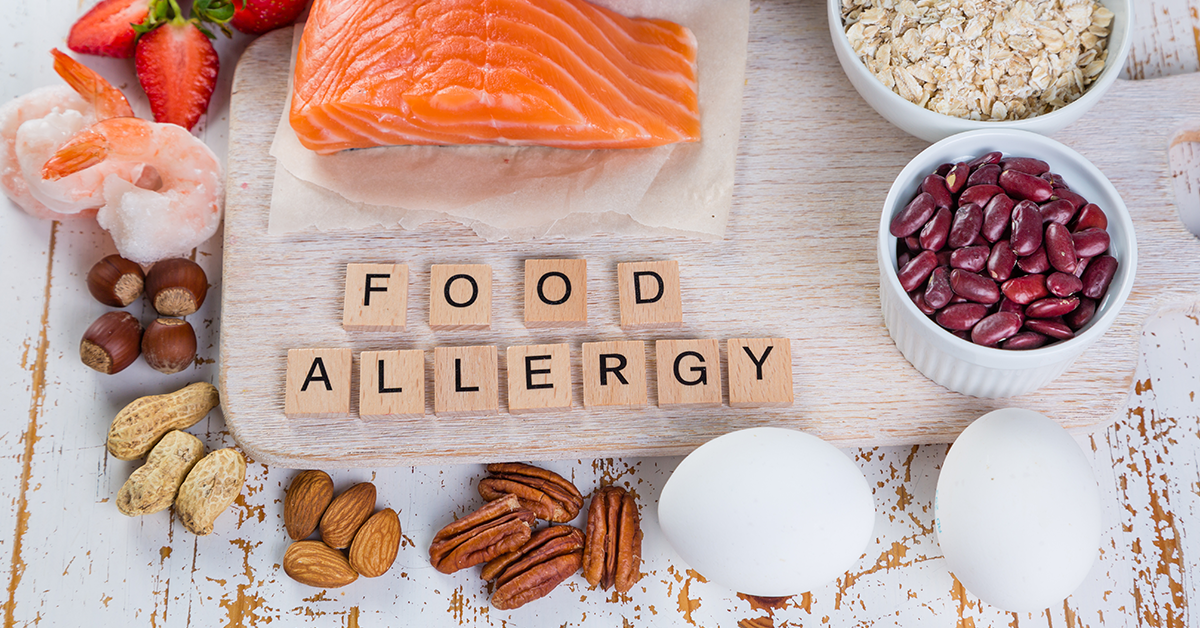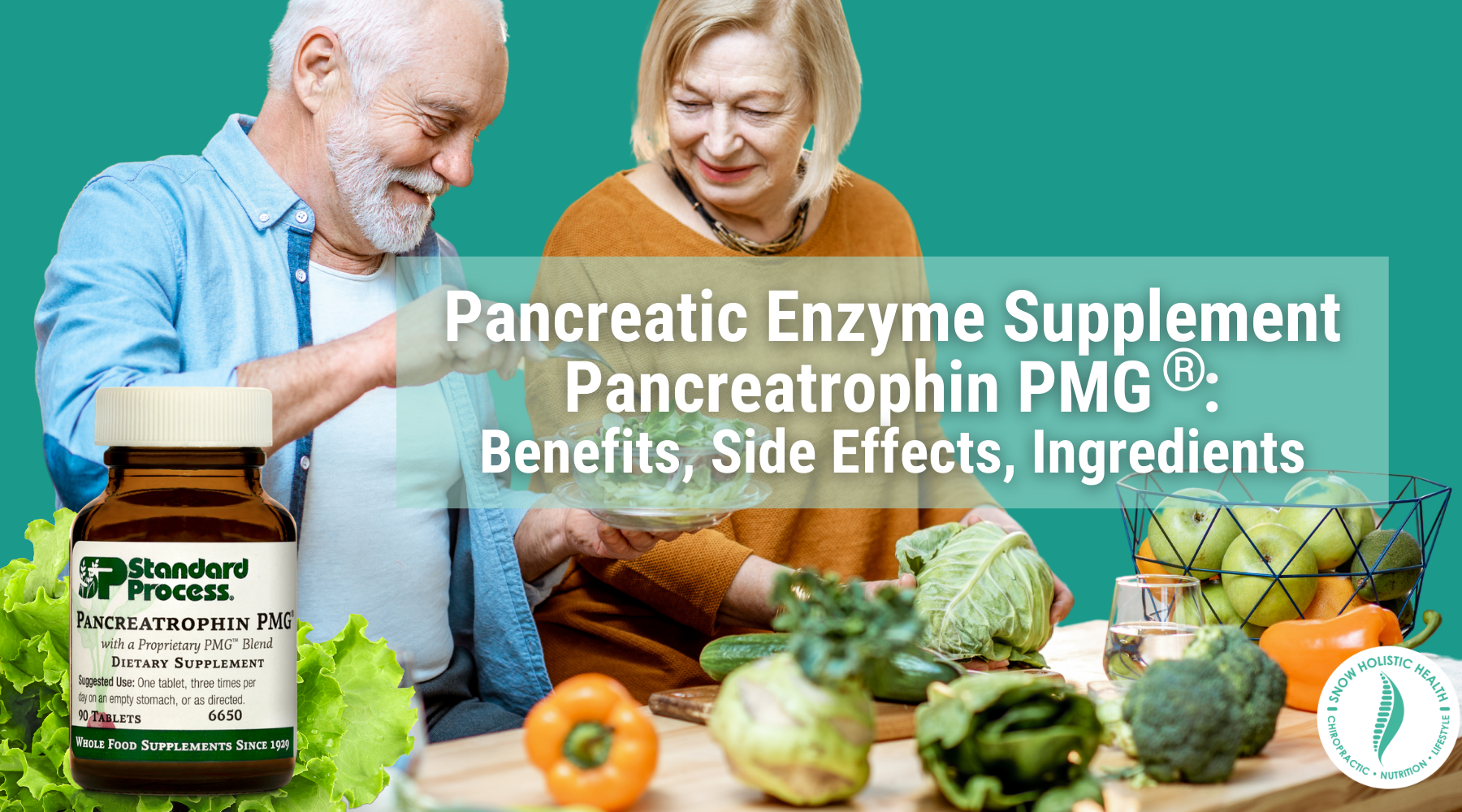Top 6 food allergies and how they can lead to gut problems

Pesky symptoms like fatigue, headache, period symptoms, bad skin, and digestive problems may be common, but they are not healthy. These symptoms are linked to chronic inflammation, which is a result of leaky gut or intestinal permeability.
Your gut has a one-layer cell barrier between the gut content and the gut immune system 1. This barrier is crucial because it is responsible for absorbing nutrients from food and keeping the gut content from the rest of your internal organs 2. If this barrier is breached, then the content inside your gut, including food particles and bacteria toxins, can reach your gut immune system. Because 80% of your immune system is in the gut, a leaky gut can cause inflammation throughout your body.
Now, we know that the modern Standard American Diet is not very healthy because it has many foods engineered to taste good and be profitable. However, some proteins in these foods can breach your gut barrier and cause inflammation throughout your body.
What are food allergies?
Your medical doctor may be aware of food allergies as allergic reactions to food. For example, you may know someone who gets an itchy mouth when they eat kiwis, or someone who has severe reactions to peanuts. These responses are genuine allergic reactions, mediated by a type of antibodies called Immunoglobulin E (IgE). True allergic reactions are immediate and severe, but resolve entirely after the allergens are removed.
Another type of food allergies refers to delayed inflammatory symptoms you get from food. For example, many people get joint pain, brain fog, and headache in response to gluten or tomatoes. Immune responses other than IgE, such as Immunoglobulin G (IgG) mediate these food-source inflammation 3.
Some people also have food intolerances, which result from their inability to digest some substances.
The best way to test for this type of food allergy is to completely stop eating the suspected food before bringing them back. If the food indeed causes inflammation in your body, your symptoms should subside once you stop eating it and return when you bring them back. However, new blood tests have also made it possible to detect this type of food allergies.
How does food allergy occur?
Food allergies are not normal but rather a state of an overactive immune response. There are a few reasons many people now have food allergies.
1) Loss of immune tolerance
Any protein that reaches your immune cells can activate your immune system. Naturally, your immune system should be able to distinguish a safe protein from one that belongs to a dangerous item, such as a germ or a cancer cell. This safe protein could be a protein from your own cells or a harmless item such as food or pollen. This “skill” of your immune system to distinguish harmful from harmless proteins is called “tolerance,” as in the ability to tolerate or ignore the harmless item 4.
Tolerance is a skill for your immune system because early life exposure trains your immune system. One of the reasons the incidences of allergies, autoimmune diseases, and food allergies are increasing is because we grew up in an unnaturally clean environment. If you and your mother grew up in a farm or around animals, you would have less risk of allergies 5. Exposure to infectious diseases as a young child may also train the immune system for a strong immune response to infectious diseases and good tolerance to harmless proteins 6.
As adults, there are many things you can do to support your immune tolerance. Therefore, you want to maintain a healthy microbiome, so using probiotics and feeding the friendly bacteria right is a key strategy.
2) Leaky gut
Your gut barrier is a one-cell layer barrier that separates between your gut content and your gut immune system. A healthy gut should be permeable enough to absorb nutrients and water, but not so leaky that proteins in your gut can reach your gut immune system.
The cells that line your gut are tightly sealed together with protein threads, so they look almost like they are zipped together. These seals are called tight junctions. Many factors can open up the seals, such as infections, stress, gluten, and head trauma 7–9.
Having a leaky gut exposes your gut immune system to proteins and bacterial toxins inside your gut. Sometimes the gut content, especially bacterial toxins, can leak into the bloodstream.
If you have a healthy level of immune tolerance, you may not have any issue with a slightly leaky gut because your immune system can ignore the leaked gut content. But a very leaky gut, or having both low tolerance and a leaky gut can cause chronic inflammation.
3) Genetic and other susceptibilities
Some autoimmune and allergic conditions run in the family, suggesting that genetics is at play. However, families also tend to share the same environment and eat the same foods 10.
Toxic substances, such as mold and pesticides, may also increase the risk for food allergies 11. These substances can affect both the gut bacteria and your immune cells.
Health Effects of Food Allergies
Many people who have food allergies don’t know that their symptoms are due to food. Here are some of the health effects of food allergies:
Stubborn weight gain and insulin resistance - An open gut barrier can cause bacterial toxins, such as lipopolysaccharides, to leak into the bloodstream. This causes low-grade inflammation that contributes to stubborn obesity, insulin resistance, and elevated cholesterol 12. LPS is also linked to brain fog, Alzheimer’s, and depression 13–15.
Autoimmune conditions - With leaky gut, fragments of incompletely digested proteins can be exposed to your immune system. Some of these fragments, especially in common food allergens, resemble parts of our organs. For example, incompletely digested fragments from milk and wheat are similar to proteins in cells that wrap our nerves and insulin-producing pancreatic cells 16. In people who are otherwise susceptible and have leaky guts, food allergies may trigger autoimmune diseases.
Inflamed gut lining - Having inflammatory food allergens in your gut every day can keep the gut lining inflamed 17. Aside from functioning as a barrier, your gut lining also includes cells that produce enzymes and stimulate movements. An inflamed gut lining is not going to digest and absorb food well, resulting in nutrient deficiencies and bad bacteria overgrowth in the upper gut. In fact, many women with iron deficiency anemia have inflamed gut lining with no symptoms 18.
Gut inflammation may also further lead to other food intolerances due to lack of enzymes. For example, lactase and histamine intolerance can result from the inflammation of the gut barrier.
An inflamed gut lining also creates an unfriendly environment for your good gut bacteria, thus promoting dysbiosis. Therefore, continuing to eat inflammatory foods could negate the benefits of taking probiotics 19.
Top six food allergies
In our practice, these six foods are frequent flyers because they are more allergenic in nature. Unfortunately, these are everywhere in the American food supply, sometimes even hidden.
-
Gluten
Gluten is a family of very sticky and allergenic proteins found in wheat. It gives your bread and pasta the chewy feels, and some sauces the velvety thickness.
Usually, your gut should be able to fully break down any protein into individual amino acids. Due to the structure of the protein, nobody can fully digest gluten 20. Incompletely digested parts of gluten can create molecular mimicry, sometimes leading to Celiac disease in susceptible people. However, non-Celiac gluten sensitivity can also trigger leaky gut, leading to digestive problems and other inflammatory symptoms 21.
Aside from wheat, gluten is also found in rye and barley. It is a common contaminant in oatmeals and other cereals. Gluten is one type of food allergy that a very trace amount can make people very sick. Hence, people who are very sensitive to gluten need to make sure their food comes from a gluten-free facility.
2) Dairy
Babies naturally have leaky gut so that they can take up immunity from the mother’s milk. Milk as a food can cause leaky gut also in adults. By inhibiting protein-digesting enzymes 22, it increases the amount of digestive enzymes to the point that the enzymes start to chew up the tight junctions.
Casein, a dairy protein, can be incompletely digested, leaving fragments that could influence our physiology when absorbed into the bloodstream. The milk that is common in the US called A1 milk is the more dangerous one. It can act like morphine and have addictive effects 23. It can also contribute to digestive symptoms and the development of type 1 diabetes 24,25.
Cow’s milk allergy is a more common food allergy, contributing to allergic symptoms, hives, and asthma 26. Some people experience improved skin condition once they get off dairy 27. Dairy products can often increase mucus in the respiratory tract and ear canal, so you may find that the mucus or infection-like symptoms subside once you remove the dairy. Dr. Eric Snow himself struggled with chronic ear infection symptoms as a child, which completely disappeared once he removed dairy.
3) Corn
A lot of corn grown in the US is genetically modified to contain a pesticide protein called Bacillus thuringiensis toxin. This protein can resist digestion and poke holes in the gut lining of insects 28. It might also do the same thing for humans 29.
Because the government subsidizes corn in the US, it becomes a cheap ingredient omnipresent in nearly all the foods. Cattle farmers feed their animals with a lot of it.
Corn is in more food than you realize. It’s gluten-free, but still very sugary and inflammatory. Many food ingredients, such as high-fructose corn syrup, modified starch, and vegetable oils come from corn. Flavoring agents, such as citric and malic acid, could also be made from fermenting corn. Aside from corn on the cob and tacos, you’d also have to read labels and pay attention to these corn derivatives.
4) Soy
Soy allergy is a common food allergy in children, suggesting that it has components that stimulate the immune system and compromise the gut barrier 30. Even soybean dust can trigger lung problems and induce allergies in bakery workers who bake with soybean flour31 . While soy is a good plant-based source of complete proteins, a lot of non-organic soybeans on the market are genetically modified and heavily sprayed with pesticides 29.
Many soybean proteins are highly allergenic. In addition, it is high in inhibitors of protein-digesting enzymes 32, which can increase the enzyme production so much that the enzymes chew up the tight junctions.
Soybeans are also high in isoflavones, which can disrupt thyroid and estrogen functions 33. Men and people with thyroid hormones have to be especially careful about their soy intake.
Like corn, soy is ubiquitous in our food supply. It is not only in soy sauce and tofu but could also be a component of baked goods, canned soup and fish, low-fat products, oil, high-protein items, and sauces. To avoid soybeans, it is important to recognize these ingredients in food labels.
5) Chocolate
Chocolate, at least ones without the sugar, could be a nutritious food that makes you happy. We associate chocolate with celebrations, joyous occasions, and gifting.
Unfortunately, chocolate allergy is a common one. Chocolate is high in histamines, which can trigger respiratory and gut symptoms, especially in people with allergic tendencies 34. Chocolate also contains components that can stimulate the immune system and cause inflammation 35.
Also, chocolate food products tend to come with other ingredients, including sugar, dairy, and soy-based. These ingredients can irritate the gut lining, triggering or worsening food allergies.
6) Food additives
Many food additives in the Food and Drug Administration’s Generally Recognized As Safe list cause leaky gut and inflammation. Because they are legally allowed, these ingredients are commonplace in the food supply. For example:
Carboxymethylcellulose and carrageenan are emulsifiers, or substances that help oils suspend in water and maintain mouthfeel. They can cause gut inflammation and trigger inflammatory bowel disease 36.
Monosodium glutamate (MSG) is another food additive that adds the umami taste by releasing free glutamate. Because glutamate is our most abundant neurotransmitter, MSG can cause neurologic symptoms in people with leaky gut and leaky brain. MSG at a high dose may cause headaches for some people 37.
Synthetic food colors are also common food allergens. It is linked to ADHD, skin problems, and anaphylaxis, especially in children 38,39.
Conclusion
If you struggle with pesky symptoms like fatigue, skin problems, brain fog, or even high cholesterol, you may be consuming inflammatory foods. Also, many people suffer from inflammation due to common food or food additives. The best way to find out if these foods are problematic is to remove them, repair your gut, and then re-introduce them. To do it with us, join our 30-day Eat and Be Well Challenge.
References:
- Vancamelbeke, M. & Vermeire, S. The intestinal barrier: a fundamental role in health and disease. Expert Rev. Gastroenterol. Hepatol. 11, 821–834 (2017).
- Turner, J. R. Intestinal mucosal barrier function in health and disease. Nat. Rev. Immunol. 9, 799–809 (2009).
- Ryu, J. et al. Fabrication of Microarrays for the Analysis of Serological Antibody Isotypes against Food Antigens. Sensors 19, (2019).
- Romagnani, S. Immunological tolerance and autoimmunity. Intern. Emerg. Med. 1, 187–196 (2006).
- Riedler, J. et al. Exposure to farming in early life and development of asthma and allergy: a cross-sectional survey. Lancet 358, 1129–1133 (2001).
- Okada, H., Kuhn, C., Feillet, H. & Bach, J.-F. The ‘hygiene hypothesis’ for autoimmune and allergic diseases: an update. Clin. Exp. Immunol. 160, 1–9 (2010).
- Bischoff, S. C. et al. Intestinal permeability--a new target for disease prevention and therapy. BMC Gastroenterol. 14, 189 (2014).
- Fasano, A. All disease begins in the (leaky) gut: role of zonulin-mediated gut permeability in the pathogenesis of some chronic inflammatory diseases. F1000Res. 9, (2020).
- Zhu, C. S., Grandhi, R., Patterson, T. T. & Nicholson, S. E. A Review of Traumatic Brain Injury and the Gut Microbiome: Insights into Novel Mechanisms of Secondary Brain Injury and Promising Targets for Neuroprotection. Brain Sci 8, (2018).
- Kivistö, J. E. et al. Genetic and environmental susceptibility to food allergy in a registry of twins. J. Allergy Clin. Immunol. Pract. 7, 2916–2918 (2019).
- Jerschow, E. et al. Dichlorophenol-containing pesticides and allergies: results from the US National Health and Nutrition Examination Survey 2005-2006. Ann. Allergy Asthma Immunol. 109, 420–425 (2012).
- Boulangé, C. L., Neves, A. L., Chilloux, J., Nicholson, J. K. & Dumas, M.-E. Impact of the gut microbiota on inflammation, obesity, and metabolic disease. Genome Med. 8, 42 (2016).
- Sun, J. et al. IL-17A is implicated in lipopolysaccharide-induced neuroinflammation and cognitive impairment in aged rats via microglial activation. J. Neuroinflammation 12, 165 (2015).
- Kowalski, K. & Mulak, A. Brain-Gut-Microbiota Axis in Alzheimer’s Disease. J. Neurogastroenterol. Motil. 25, 48–60 (2019).
- André, P., Laugerette, F. & Féart, C. Metabolic Endotoxemia: A Potential Underlying Mechanism of the Relationship between Dietary Fat Intake and Risk for Cognitive Impairments in Humans? Nutrients 11, (2019).
- Vojdani, A. Molecular mimicry as a mechanism for food immune reactivities and autoimmunity. Altern. Ther. Health Med. 21 Suppl 1, 34–45 (2015).
- Ohtsuka, Y. Food intolerance and mucosal inflammation. Pediatr. Int. 57, 22–29 (2015).
- Annibale, B. et al. Gastrointestinal causes of refractory iron deficiency anemia in patients without gastrointestinal symptoms. Am. J. Med. 111, 439–445 (2001).
- Zeng, M. Y., Inohara, N. & Nuñez, G. Mechanisms of inflammation-driven bacterial dysbiosis in the gut. Mucosal Immunol. 10, 18–26 (2017).
- Araya, R. E. et al. Mechanisms of innate immune activation by gluten peptide p31-43 in mice. Am. J. Physiol. Gastrointest. Liver Physiol. 311, G40–9 (2016).
- Barbaro, M. R., Cremon, C., Stanghellini, V. & Barbara, G. Recent advances in understanding non-celiac gluten sensitivity. F1000Res. 7, (2018).
- Lindberg, T. Protease inhibitors in human milk. Pediatr. Res. 13, 969–972 (1979).
- Ho, S., Woodford, K., Kukuljan, S. & Pal, S. Comparative effects of A1 versus A2 beta-casein on gastrointestinal measures: a blinded randomised cross-over pilot study. Eur. J. Clin. Nutr. 68, 994–1000 (2014).
- Küllenberg de Gaudry, D. et al. Milk A1 β-casein and health-related outcomes in humans: a systematic review. Nutr. Rev. 77, 278–306 (2019).
- Chia, J. S. J. et al. A1 beta-casein milk protein and other environmental pre-disposing factors for type 1 diabetes. Nutr. Diabetes 7, e274 (2017).
- Caffarelli, C. et al. Cow’s milk protein allergy in children: a practical guide. Ital. J. Pediatr. 36, 5 (2010).
- Lifschitz, C. & Szajewska, H. Cow’s milk allergy: evidence-based diagnosis and management for the practitioner. Eur. J. Pediatr. 174, 141–150 (2015).
- Koch, M. S. et al. The food and environmental safety of Bt crops. Front. Plant Sci. 6, 283 (2015).
- Then, C. & Bauer-Panskus, A. Possible health impacts of Bt toxins and residues from spraying with complementary herbicides in genetically engineered soybeans and risk assessment as performed by the European Food Safety Authority EFSA. Environ Sci Eur 29, 1 (2017).
- Savage, J. H., Kaeding, A. J., Matsui, E. C. & Wood, R. A. The natural history of soy allergy. J. Allergy Clin. Immunol. 125, 683–686 (2010).
- Quirce, S., Fernández-Nieto, M., Polo, F. & Sastre, J. Soybean trypsin inhibitor is an occupational inhalant allergen. J. Allergy Clin. Immunol. 109, 178 (2002).
- L’Hocine, L. & Boye, J. I. Allergenicity of soybean: new developments in identification of allergenic proteins, cross-reactivities and hypoallergenization technologies. Crit. Rev. Food Sci. Nutr. 47, 127–143 (2007).
- Doerge, D. R. & Sheehan, D. M. Goitrogenic and estrogenic activity of soy isoflavones. Environ. Health Perspect. 110 Suppl 3, 349–353 (2002).
- Lopes, J. P., Kattan, J., Doppelt, A., Nowak-Węgrzyn, A. & Bunyavanich, S. Not so sweet: True chocolate and cocoa allergy. J. Allergy Clin. Immunol. Pract. 7, 2868–2871 (2019).
- Erridge, C. The capacity of foodstuffs to induce innate immune activation of human monocytes in vitro is dependent on food content of stimulants of Toll-like receptors 2 and 4. Br. J. Nutr. 105, 15–23 (2011).
- Martino, J. V., Van Limbergen, J. & Cahill, L. E. The Role of Carrageenan and Carboxymethylcellulose in the Development of Intestinal Inflammation. Front Pediatr 5, 96 (2017).
- Obayashi, Y. & Nagamura, Y. Does monosodium glutamate really cause headache? : a systematic review of human studies. J. Headache Pain 17, 54 (2016).
- Arnold, L. E., Lofthouse, N. & Hurt, E. Artificial food colors and attention-deficit/hyperactivity symptoms: conclusions to dye for. Neurotherapeutics 9, 599–609 (2012).
- Feketea, G. & Tsabouri, S. Common food colorants and allergic reactions in children: Myth or reality? Food Chem. 230, 578–588 (2017).



